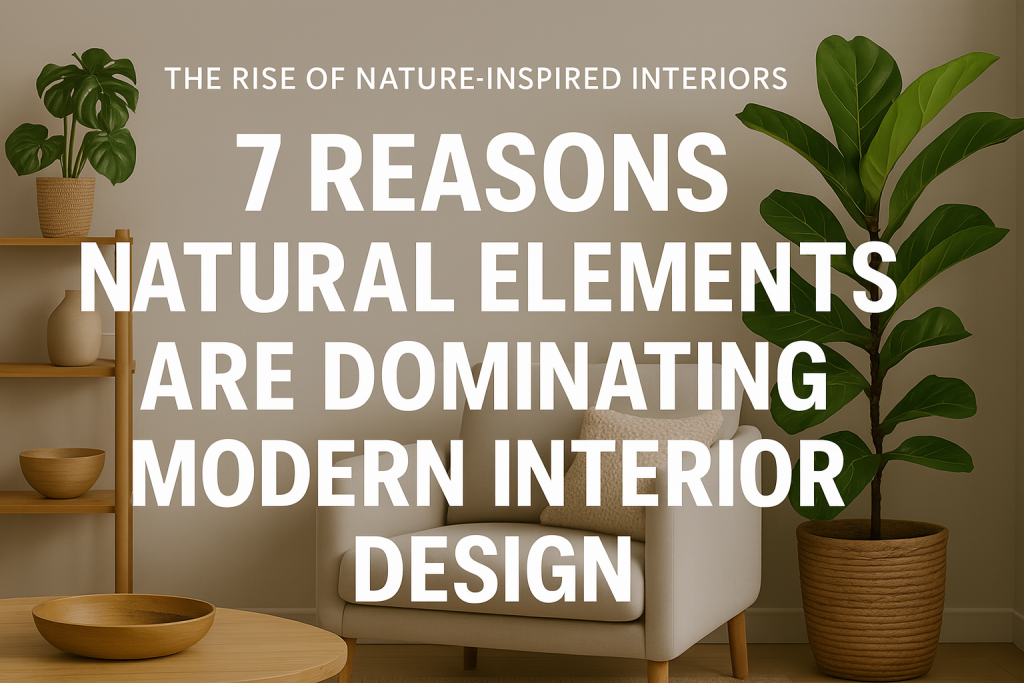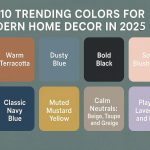The Rise of Nature-Inspired Interiors
In recent years, the world of interior design has witnessed a significant shift toward natural elements. From raw wood accents to lush indoor plants, homeowners and designers alike are embracing nature for its beauty, sustainability, and calming presence. As our lives become increasingly connected to technology and urban environments, the desire to reconnect with nature inside our homes has never been more powerful.
This movement isn’t just about aesthetics—it’s grounded in scientific research and a growing awareness of environmental wellness. Let’s explore the driving forces and benefits behind the resurgence of natural elements in interior design, along with expert tips for bringing the outdoors inside.
1. Biophilic Design: Creating Healthier Living Spaces
Understanding Biophilic Design Principles
Biophilic design refers to the practice of incorporating natural elements to foster a connection with nature inside built environments. Studies show that exposure to natural features—like greenery, sunlight, and organic textures—can reduce stress, boost mood, and improve overall well-being.
Health Benefits Backed by Science
Research published in the International Journal of Environmental Research and Public Health found that individuals surrounded by nature-inspired interiors experienced decreased levels of anxiety and increased cognitive function. Adding plants, water features, or natural materials to your home can have a measurable impact on your mental and physical health.
2. Sustainability and Eco-Friendly Choices
The Environmental Impact of Natural Materials
As eco-consciousness grows, more people are seeking sustainable materials for their homes. Elements like reclaimed wood, bamboo, cork, and stone are not only renewable but also reduce the carbon footprint compared to synthetic alternatives. These materials often require less processing, meaning fewer chemicals and pollutants in your living space.
Tips for Making Eco-Friendly Design Choices
- Choose FSC-certified wood products for furniture and flooring.
- Opt for stone or tile sourced from local quarries to minimize transport emissions.
- Repurpose vintage or salvaged materials for a unique, sustainable touch.
3. Creating Warmth and Comfort with Organic Textures
The Power of Texture in Interior Design
Natural textures add a depth and warmth that synthetic materials often lack. Elements like woven jute rugs, linen drapes, and unpolished stone create inviting spaces that feel both luxurious and grounded. These tactile details encourage relaxation and make interiors more livable.
Layering Textures for a Cozy Ambience
Try mixing multiple natural textures for a layered effect: pair wool throws with rattan baskets, or blend rough-hewn wood with soft cotton upholstery. This approach not only adds visual interest but also enhances the sensory experience of your home.
4. Enhancing Aesthetic Appeal with Timeless Beauty
Why Natural Elements Never Go Out of Style
Unlike fleeting trends, nature-inspired décor stands the test of time. Wood grains, stone veining, and leafy greens offer a classic elegance that fits any design style, from rustic to contemporary. Natural imperfections add character and uniqueness, making each piece a work of art.
Practical Tips for Styling with Nature
- Use large potted plants as statement pieces in living rooms or entryways.
- Expose architectural features like brick or stone walls to highlight natural character.
- Display collections of shells, driftwood, or minerals as organic décor accents.
5. Promoting Wellness and Mental Clarity
The Psychological Impact of Green Spaces
Introducing greenery and organic elements into your home can have profound effects on mental wellness. Studies suggest that indoor plants not only purify air but also help increase concentration and creativity. The act of nurturing plants provides a sense of accomplishment and mindfulness.
Easy Ways to Add Greenery Indoors
- Start with low-maintenance plants like snake plants or pothos.
- Create a small herb garden in your kitchen for freshness and flavor.
- Arrange hanging planters in sunny windows to maximize space and light.
6. Maximizing Light and Space with Natural Design
Optimizing Natural Light
Natural design often emphasizes maximizing sunlight to create bright, airy spaces. Large windows, skylights, and glass doors allow sunlight to flood interiors, promoting better sleep cycles, productivity, and mood. Reflective surfaces like mirrors also amplify natural light, making even small rooms feel more expansive.
Bringing the Outdoors In
Blurring the boundaries between indoor and outdoor spaces is a growing trend. Folding glass walls, indoor gardens, and transitional patios enable homeowners to enjoy nature year-round. This seamless integration creates a sense of harmony and freedom within the home.
7. Personal Expression Through Nature-Inspired Design
Customizing with Natural Artifacts
One of the greatest benefits of incorporating natural elements is the opportunity for personal expression. Whether it’s handcrafted pottery, locally sourced driftwood, or family-heirloom timber furniture, these pieces tell a story and reflect your unique style.
Supporting Local Artisans and Crafts
Choosing handmade or artisanal natural décor supports small businesses and preserves traditional craftsmanship. Look for local makers who work with indigenous materials, adding authenticity and ethical value to your interior design choices.
How to Get Started with Natural Elements in Your Home
Begin with Small Changes
You don’t need a full-scale renovation to embrace the natural elements trend. Start by introducing a few potted plants, switching out synthetic fabrics for natural ones, or adding a wooden accent table to your living room. These small touches can make a big difference in both appearance and ambiance.
Invest in Quality Over Quantity
Prioritize well-crafted, sustainable pieces that will last for years to come. Quality natural materials age beautifully and often gain more character with time, making them a wise investment for both your home and the planet.
Conclusion: Embrace the Power of Nature Indoors
Incorporating natural elements in interior design is more than a passing trend—it’s a holistic approach to creating healthier, more beautiful, and sustainable living spaces. By embracing natural materials, textures, and greenery, you can enjoy the timeless benefits of biophilic design while reflecting your own personal style. Whether you make subtle changes or embark on a major redesign, bring the outdoors in and experience the transformative effect of nature in your home.


